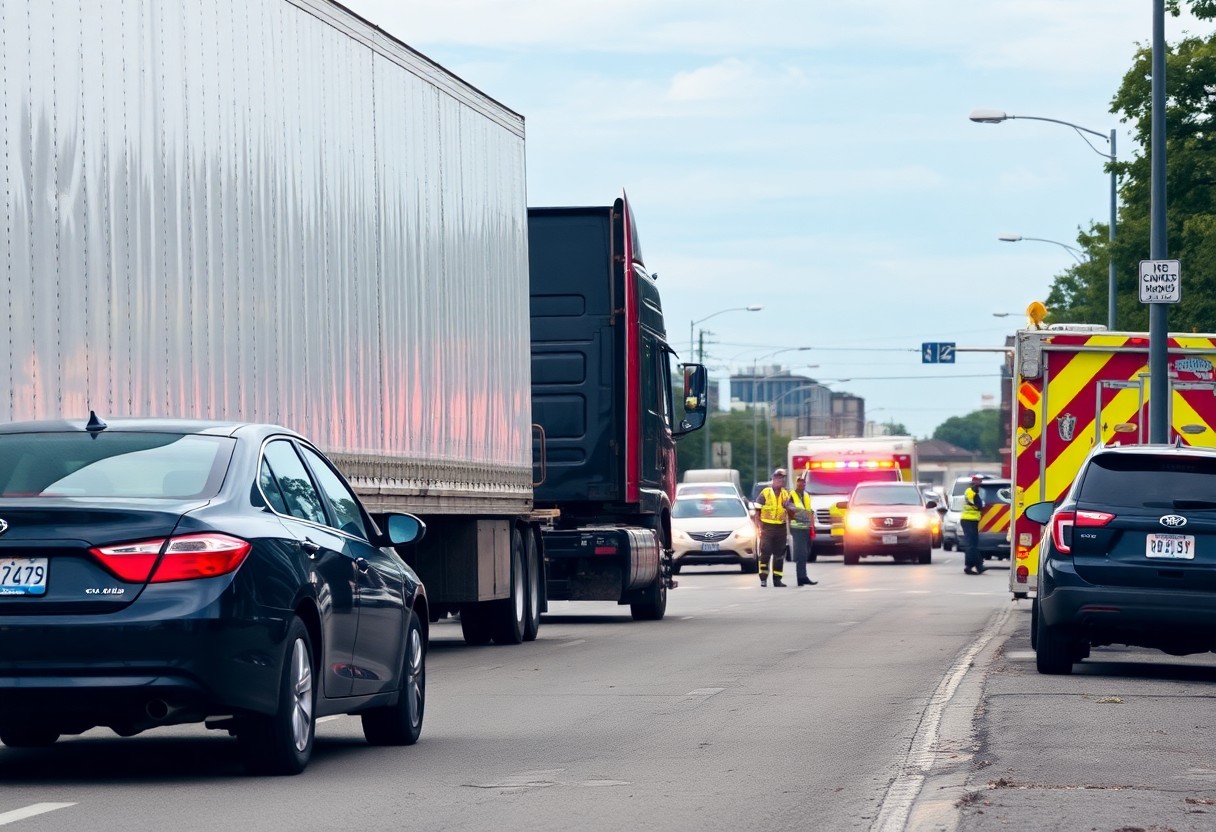Most people don’t realize how trucking routes in Huntsville can impact your daily commute and overall safety on the road. Understanding these routes is vital, as they often intersect with busy local traffic, increasing the potential for accidents. By learning about the areas of high risk and the factors contributing to collisions, you can make safer driving choices. Whether you’re a local resident or just passing through, your awareness of these routes can significantly enhance your safety and that of others around you.
Overview of Trucking Routes in Huntsville
While Huntsville is known for its vibrant economy and technological advancements, its trucking routes play a significant role in daily operations. The city serves as a hub for logistics, facilitating the movement of goods across various industries. Understanding these routes can provide you with insights into how they contribute to traffic flow, commuter experiences, and accident risks within the area.
Main Highways and Byways
Among the key transportation arteries in Huntsville, major highways such as I-565 and US-72 are crucial for truck transit. These routes connect you to neighboring cities and facilitate quick access to key commercial districts. You’ll also find various byways that help distribute local traffic while catering to the needs of freight transport.
Traffic Patterns and Volume
Highways in Huntsville experience significant fluctuations in traffic patterns, particularly during peak hours. As you navigate these routes, be aware that heavy truck traffic can increase the likelihood of accidents, especially in high-density areas. Factors such as construction activities and weather conditions also influence traffic flow and safety.
Overview of traffic patterns in Huntsville reveals that certain times of day experience peak volumes due to commuting schedules. Trucks contribute heavily to this volume, particularly near industrial sectors. You should be mindful of congested zones, where the intersection of trucks with passenger vehicles can heighten the risk of collisions. Additionally, occasional roadwork or detours can temporarily redirect traffic, further complicating navigation. Understanding these elements enhances your ability to drive safely and anticipate potential hazards on the road.
Factors Influencing Accident Risks
It is necessary to understand the various factors that can influence the risk of accidents on trucking routes through Huntsville. These factors include:
- Driver Behavior
- Road Conditions
- Weather and Visibility
- Truck Maintenance
- Traffic Volume
Assume that you are aware of these elements to better navigate and mitigate the risks on the road.
Road Conditions
Influencing accident risks, road conditions play a significant role in ensuring safe travel. Poorly maintained roads, potholes, and inadequate signage can contribute to hazardous situations. Adequate awareness of your surroundings and understanding of road conditions can help you drive more safely.
Weather and Visibility
Weather can significantly impact your trucking journey. Rain, fog, snow, and other weather conditions can reduce visibility and make road surfaces slippery. It’s vital that you adjust your driving habits according to the weather to enhance safety.
It is crucial to take note of visibility levels when navigating through weather-affected areas. Inclement weather such as heavy rain or fog can drastically impair your ability to see other vehicles and road signs, increasing the potential for accidents. Additionally, winter conditions like snow and ice require you to adjust your speed and increase following distances. By being proactive and taking necessary precautions during adverse weather, you can significantly reduce your risk of encountering accidents on the road.
Impact of Route Planning on Safety
Any trucking company knows that effective route planning plays a significant role in minimizing accident risks. By analyzing traffic patterns, road conditions, and potential hazards, you can make informed decisions that promote safer travel for drivers and other road users. Proper route selection not only enhances efficiency but also helps in avoiding high-risk areas notorious for frequent accidents.
Strategic Routes vs. High-Risk Areas
Any time you plan a trucking route, you face the decision between taking a strategic route for efficiency or navigating high-risk areas that could jeopardize safety. Choosing routes that bypass known accident hotspots can reduce the likelihood of unforeseen incidents, allowing you to not only keep your vehicles safe but also protect the lives of other motorists.
Role of GPS and Navigation Technology
By leveraging the latest GPS and navigation technology, you can significantly improve route planning for safety. These tools provide real-time data on traffic, road conditions, and accident-prone areas, allowing you to adapt your routes accordingly.
With the help of advanced GPS and navigation technology, you gain access to real-time information that can enhance the safety of your routes. Updates on traffic conditions and alerts about accident-prone zones enable you to make dynamic adjustments to your paths. Furthermore, these technologies can suggest alternative routes that avoid high-risk areas, ultimately lowering the chances of encounter with dangerous environments. By incorporating these tools, you can significantly minimize the risk factors associated with trucking, ensuring not only the safety of your drivers but also improving operational efficiency.

Case Studies: Accidents on Trucking Routes
Despite the careful planning of trucking routes through Huntsville, accidents remain a serious concern. A review of recent data revealed the following case studies:
- 2019: A multi-vehicle pileup involving a truck resulted in 5 injuries on Highway 231.
- 2020: A collision at an intersection led to 2 fatalities on Cedar Lane, attributed to truck driver error.
- 2021: A runaway truck accident occurred on I-565, resulting in extensive property damage but no injuries.
- 2022: A distracted driving incident involved a truck hitting a cyclist, causing serious injuries.
Analysis of Recent Incidents
For an effective understanding of the risks associated with trucking routes, you should analyze the most recent incidents. These cases highlight the need for improved safety measures and road awareness, as factors like insufficient signage and traffic congestion often play key roles in accidents.
Common Contributing Factors
On examining the incidents, several common contributing factors were identified:
- Distracted Driving: Engaging with phones or navigation devices.
- Driver Fatigue: Long hours leading to impaired judgment.
- Adverse Weather: Rain or fog increasing risks of accidents.
- Poor Road Conditions: Potholes or debris on the roadway.
Recognizing these factors can greatly enhance your understanding of how to avoid potential accidents while navigating Huntsville’s trucking routes.
To further comprehend the risks, you should probe deeper into the common contributing factors of trucking accidents. Specifically:
- Driver Distraction: Taking attention away from the road, leading to critical errors.
- Inadequate Training: Lack of proper guidance contributes to unsafe driving practices.
- Heavy Traffic: Increased vehicle density often escalates the likelihood of collisions.
- Vehicle Maintenance Issues: Insufficient upkeep of trucks can impair functionality.
Recognizing the significance of these factors will empower you with knowledge to make safer decisions while sharing the road with large vehicles.
Prevention Strategies for Reducing Risks
Keep in mind that implementing effective prevention strategies can significantly reduce accident risks associated with trucking routes in Huntsville. By focusing on driver education, training, and infrastructure improvements, you can enhance safety for both truck drivers and other road users.
Driver Education and Training
Across the trucking industry, comprehensive driver education and training programs are crucial for ensuring safety. By providing your drivers with the necessary skills and knowledge, you can help them navigate Huntsville’s complex routes and reduce the likelihood of accidents.
Infrastructure Improvements
Across Huntsville, the need for infrastructure improvements is evident in enhancing roadway safety. Updating traffic signals, adding dedicated truck lanes, and improving signage can significantly contribute to reducing accidents involving trucks.
Improvements in infrastructure are vital to enhancing safety on Huntsville’s trucking routes. By investing in better road surfaces, you can reduce accident risks associated with vehicle wear and tear. Additionally, implementing clear signage and dedicated lanes for trucks can minimize confusion for both drivers and pedestrians. Moreover, upgrading traffic control systems can improve traffic flow, reducing the likelihood of collisions. As you advocate for these enhancements, you contribute to creating a safer driving environment for everyone.
Regulatory Considerations
Your understanding of regulatory considerations is important when evaluating trucking routes through Huntsville. Local and state traffic laws play a significant role in determining the safety and efficiency of transport operations. Familiarizing yourself with these laws ensures that trucking companies remain compliant, thus reducing the likelihood of accidents on the road.
Local and State Traffic Laws
Across Huntsville, local and state traffic laws dictate safe driving practices, speed limits, and restricted areas for large trucks. Adhering to these regulations helps mitigate risks of accidents, ensuring that both motorists and truck drivers can navigate the roads safely. Having a solid grasp of these rules can significantly impact your safety on the road.
Compliance and Safety Enforcement
At the local and state levels, authorities actively enforce compliance with safety regulations aimed at reducing accidents. This enforcement includes regular inspections of commercial vehicles, monitoring for adherence to weight limits, and ensuring that drivers possess the appropriate licenses. These measures contribute positively to road safety.
Compliance with safety regulations is vital for trucking companies operating in Huntsville. Failure to meet these standards can lead to penalties and heightened risk of accidents. Moreover, consistent safety checks and training for drivers are critical components in maintaining a dedicated focus on safety. By prioritizing these practices, you can foster a more secure driving environment, ultimately benefiting both truck drivers and the general public.
Final Words
From above, it’s clear that the trucking routes through Huntsville significantly influence accident risks, impacting not only truck drivers but also local motorists and pedestrians. By understanding the complexities of these routes, including traffic patterns and potential hazards, you can better navigate the area and enhance your safety. Awareness of peak congestion times and road characteristics can help you make informed decisions while driving. Ultimately, staying vigilant and proactive can contribute to a safer driving experience for everyone on the road.



















